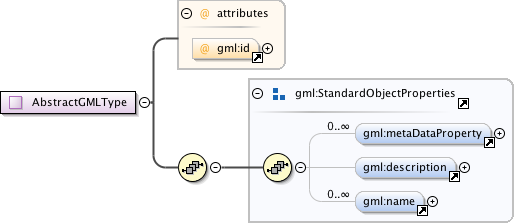| Namespace | http://www.opengis.net/gml | ||||||||||||
|
Annotations
|
All complexContent GML elements are directly or indirectly derived from this abstract supertype
to establish a hierarchy of GML types that may be distinguished from other XML types by their ancestry.
Elements in this hierarchy may have an ID and are thus referenceable.
|
||||||||||||
|
Diagram
|
 |
||||||||||||
|
Properties
|
|
||||||||||||
|
Used by
|
|
||||||||||||
| Model | gml:metaDataProperty* , gml:description{0,1} , gml:name* | ||||||||||||
| Children | gml:description, gml:metaDataProperty, gml:name | ||||||||||||
|
Attributes
|
|
||||||||||||
|
Source
|
|
||||||||||||
| Schema location | http://schemas.opengis.net/gml/3.1.1/base/gmlBase.xsd |